Remediation of Spent Engine Oil Polluted Soil Using Indigenous Plant Species
| Received 09 Nov, 2023 |
Accepted 27 May, 2024 |
Published 31 Dec, 2024 |
Background and Objective: Soil contamination with engine oil and other petroleum hydrocarbons is a major problem in Nigeria. The study was carried out to assess the potential of Chromolaena odorata, Aspilia africana and Axonopus compressus in the remediation of used motor oil-contaminated soil. Materials and Methods: An equal volume of soil was spiked with 16% (w/w) of used motor oil and monitored for 90 days. The experiment was laid out in a complete randomized design in three replicates each. The test plants were harvested after 90 days and analyzed for the presence of heavy metals using AAS. The results obtained were analyzed using Microsoft Excel. Results: The variable concentrations of heavy metals and TPH were accumulated by the test plants from the contaminated soil and were stored in the root, shoot and leaf. Metal accumulation patterns were in the order: Chromolaena odorat>A. africana>A. compressus. Chromolaena odorata and A. africana exhibited characteristics typical of a phytoextractor while A. compressus could be applied as a phytostabiliser of spent engine oil-polluted soils. The result further showed that TPH content of C. odorata accumulated the highest level of TPH (178.43 mg/kg) in the leaf followed by A. compressus (46.58 mg/kg) and A. africana (26.26 mg/kg). Conclusion: Thus, Chromolaena odorata, Aspilia africana and Axonopus compressus possess hyper-accumulative uptake capacity for bioavailable residual oil heavy metals and therefore could be suitable for the phytoremediation of spent engine oil-contaminated soil.
INTRODUCTION
Remediation of contaminated soils falls into four major types viz: Chemical, physical, thermal, or biological techniques (phytoremediation and bioremediation)1-3. Most of the remediation techniques focus on exploiting or altering soil chemistry to either remove contaminants from the soil or to reduce their solubility and bioavailability4-7. Chemical remediation is based on chemical oxidation that eliminates harmful compounds from the contaminant. This technique is relatively fast but may negatively impact the surrounding ecosystem. Physical method (which includes excavation and washing) involves transportation of contaminated soil from source to an area for disposal, while in the second part (washing), contaminated soil is washed with organic solvents which eventually removes the contaminants8.
Again, the high cost of chemicals and the threat to flora and fauna makes this method less applicable. Thermal technique entails desorption of and incineration which is very expensive with its attendant environmental pollution9. Based on this, a plant-based remediation technique known as phytoremediation is by far considered the most optimal remediation technique. It is a simple, vital, cost-effective, low-labor-intensive, widely acceptable, eco-friendly, sustainable, reliable and promising technology that is applicable in large areas, particularly when native, ecologically and socioeconomically valuable plants are used for the remediation10.
The term phytoremediation consists of the Greek prefix “phyto” which means “plant” and the Latin suffix “Remedium” which means “renew, able to cure or restore”11,12.
Plants remove contaminants from the soil through various techniques. These diverse ways in which plants interact with contaminants for eventual removal or degradation are referred to as phytoremediation techniques. Phytoremediation of contaminated soil can take place by phytoextraction, phytofilteration, phytostabilization, phytovolatilization, phytodegradation, rhizodegradation or phytodesalination13,14. This study was undertaken to evaluate remediation of spent engine oil polluted soil using indigenous plant species in Imo State Nigeria.
MATERIALS AND METHODS
Study area: Investigations were carried out from January to March, 2024 in the screen house of the Department of Biology, Federal University of Technology Owerri, Imo State located at Latitude 5.3866°N and Longitude 6.9916°E, respectively.
Pot experiment: Phytoremediation potentials of the selected hyperaccumulator species from the various auto mechanic workshops were evaluated in vivo by conducting pot experiments in the screen house. Three plant species (Chromolaena odorata, Axpnopus compressus and Aspilia africana) were selected based on phase one of this study as well as their dominance at mechanic workshops.
Experimental design: About 20 kg of soil was mixed with 16% spent engine oil, filled in polythene bags arranged in a complete randomized design and perforated at the base to avoid water logging. Each treatment was replicated three times. Two weeks after spiking with different concentrations of spent engine oil, about 100 g of soil samples were collected at the surface from each replicate, homogenized and sent to the laboratory for soil analysis prior to planting15. This was done to track the initial level of pollutants of concern in spent engine oil before transplanting16.
Laboratory studies: After 12 weeks, a post-analysis of soil and plant tissues (root, shoot and leaf) was carried out to track the phytoremediation potentials of Chromolaena odorata and Aspilia africana at the various treatment levels.
Determination of heavy metals in plant parts (root, shoot and leaf): Each subsample was oven-dried at 70°C for 24 hrs. Acid digestion method of Sing and Jain17 used for the digestion of grounded plant samples. One gram each of these was weighed into 50 mL capacity beaker, followed by addition of 10 mL mixture of analytical grade acids: HNO3, H2SO4 and HClO4 in a ratio 1:1:1. The beakers containing the samples were covered with watch glasses and left overnight. The digestion was carried out at a temperature of 70°C until about 4 mL was left in the beaker. Then, a further 10 mL of the mixture of acids was added. This mixture was allowed to evaporate to a volume of about 4 mL. After cooling, the solution was filtered to remove small quantities of waxy solids and made up to a final volume of 50 mL with distilled water. Quantitatively, the digested samples were transferred into a 125 mL plastic container, filtrated with 50 mL de-ionized water and metal analysis was performed with Buck scientific Atomic Absorption Spectrophotometer (Model GFA-EX7i, Shimadzu Corporation, Japan) using air acetylene flame with a digitalized read out system17. Results were expressed in mg/kg.
Determination of TPH in plant tissues (root, shoot and leaf): The plant parts from the different treatments were separately extracted in carbon tetrachloride. The extracts were then analyzed using IR spectroscopy following the method of Toth et al.18.
Statistical analysis: Data collected was presented in charts and tables. Mean separation was done using Duncan Multiple Range Test at a 0.05% probability level. All statistical analysis was run using SAS package, version 20.
RESULTS
Metal accumulation in C. odorata, A. africana and A. compressus after 12 weeks of exposure to spent engine oil: Results of the analysis of selected heavy metals in below (soil) and above ground (root, leaf and shoot) of C. odorata, A. compressus and A. africana after 12 weeks of exposure to different concentrations of spent engine oil were presented in Fig. 1-11 while Fig. 12 shows the TPH accumulation in test plant tissues. As demonstrated in the figures, there was a marked variation in heavy metal accumulation patterns in the different plant tissues (root, leaf and shoot). Amount of Iron extracted by the plant tissues varied. Iron accumulation in the root was highest in C. odorata with a mean value of 27.39 mg/kg, followed by A. africana (27.21 mg/kg) while the lowest level accumulation of Fe was recorded in A. compressus with a mean value of 24.31 mg/kg. Some level of Fe was also observed in the leaf. Chromolaena odorata accumulated 236.91 mg/kg, while A. africana and A. compressus recorded 22.41 and 236.9 mg/kg, respectively. The highest phytoextraction rate was observed in A. africana and C. odorata while the least was recoreded in A. compressus. At the shoot tissue of the plants, Iron content fluctuated as follows: Chromolaena odorata (26.63 mg/kg), A. africana (24.92 mg/kg) and A. compressus (22.34 mg/kg), respectively (Fig. 1).
By the end of 12 weeks of the experiment, no amount of cobalt was detected in the soil samples. The root system accumulation cobalt by C. odorata, A. africana and A. compressus were 0.053, 0.0143 and 0.0141 mg/kg. The 0.082 mg/kg was recorded in the leaf of C. odorata with no values recorded for A. africana and A. compressus in the leaf (Fig. 2). However, it was observed that the highest level of cobalt (17.43 mg/kg) was found in the shoot of C. odorata followed by A. compressus with mean value of 0.142 mg/kg and A. africana (0.053 mg/kg), respectively.
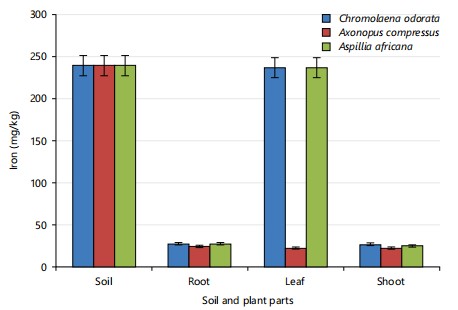
|
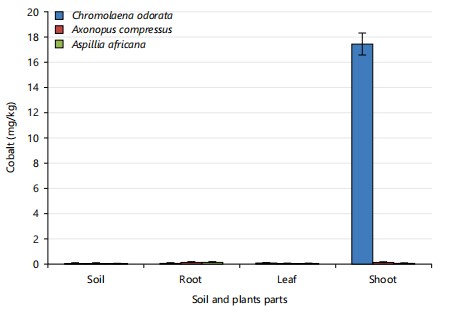
|
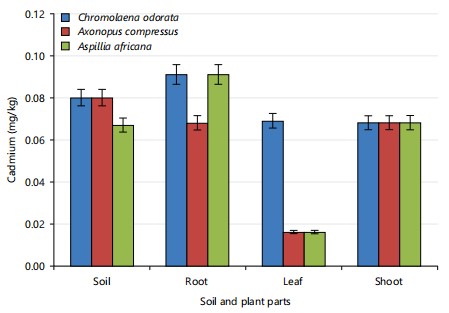
|
Cadmium accumulation was recorded mostly in the root of C. odorata and A. africana (0.091 mg/kg) while the least accumulation in root was recorded in A. compressus (0.068 mg/kg). Equal level of cadmium was observed in the shoot for each plant (0.078 mg/kg) as shown in Fig. 3. The highest accumulation of Arsenic was observed in the shoot by C. odorata (12.44 mg/kg) while the least level (0.127 mg/kg) was recorded in the leaf. A similar value (0.127 mg/kg) was also recorded for A. africana in the leaf (Fig. 4).
Uptake of manganese by C. odorata was more pronounced in the shoot when compared with other test plant parts. Equal mean values of 0.543 mg/kg were recorded in the roots of the three plants under study. However, the leaf recorded equal mean values of 0.668 mg/kg for C. odorata and A. africana (Fig. 5).
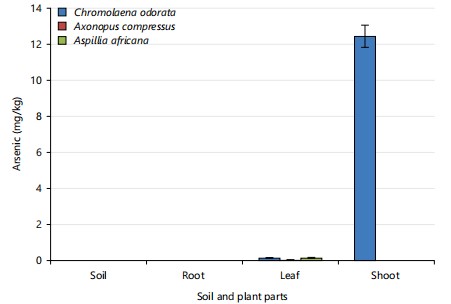
|
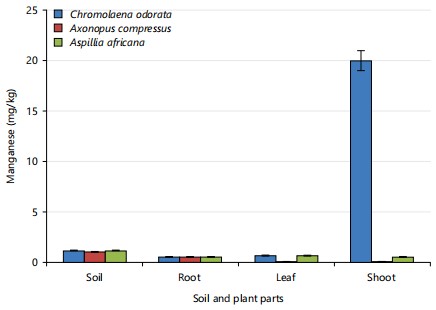
|
The mean lead concentration values in root were: Chromolaena odorata (0.063 mg/kg), A. compressus (0.064 mg/kg) and A. africana (0.048 mg/kg). Increased level of accumulation in the aerial part of the plants was also observed with respect to lead (Fig. 6). The leaves of C. odorata, A. compressus and A. africana had 0.348, 0.094 and 0.348 mg/kg, respectively. With respect to the shoot accumulation of Lead, C. odorata recorded the highest accumulation with mean value of 0.348 mg/kg followed by A. compressus (0.064 mg/kg) and A. africana (0.053 mg/kg).
Ability of the plant species to phytoextract zinc from the soil also varied. Mean zinc content in roots for C. odorata, A. compressus and A. africana were 1.038, 4.69 and 4.266 mg/kg; the leaf content was 2.203, 4.495 and 3.761 mg/kg. The shoot accumulations were 4.49, 12.66 and 11.481 mg/kg (Fig. 7). Concentration of nickel in root, leaf and shoot tissues varied as follows: Chromolaena odorata (3.55 mg/kg), A. compressus (27.34 mg/kg) and 2.761, 28.23, 27.34 and 22.17 mg/kg; while 28.23 mg/kg was observed in the shoot for C. odorata with nil recorded in A. compressus and A. africana (Fig. 8).
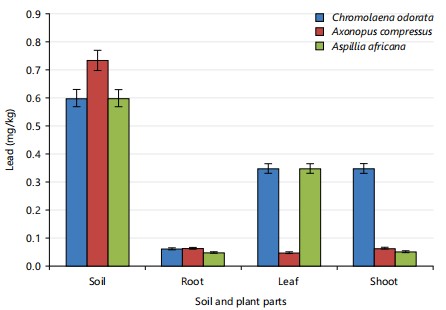
|
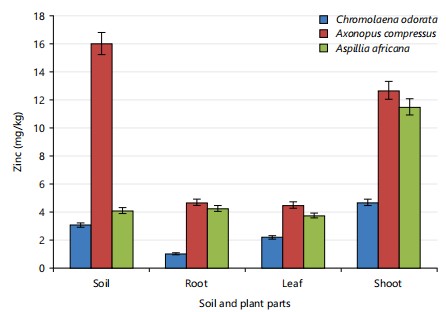
|
The highest level of copper in soil treated with C. odorata was high when compared with other test plants. In the root, concentration of copper in C. odorata, A. compressus and A. africana are 5.72, 0.068 and 0.04 mg/kg (Fig. 9). Mean concentration of copper also varied in the leaf and shoot as follows: 22.63, 0.068, 22.63, 0.04 and 0.599 mg/kg. The least accumulation of copper was recorded in A. compressus (0.04 mg/kg).
The uptake of chromium by the test plants indicated that C. odorata accumulated the highest level of chromium in root, leaf and shoot while the least accumulation was observed in A. compressus. In the root, the mean values of chromium recorded were C. odorata (8.21mg/kg), A. compressus (0.599 mg/kg) and A. Africana (0.599 mg/kg). In the leaf tissue, mean concentration were C. odorata (22.3 mg/kg) and 0.14 mg/kg for A. compressus and A. africana, respectively. Mean accumulation by C. odorata, A. compressus and A. africana in the shoot was 22.30, 0.588 and 0.589 mg/kg (Fig. 10).
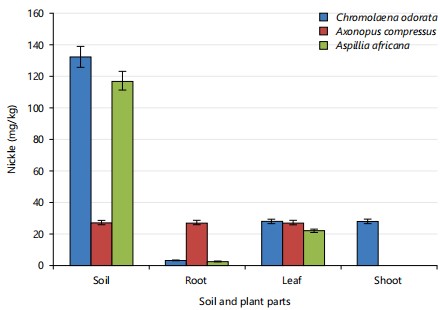
|
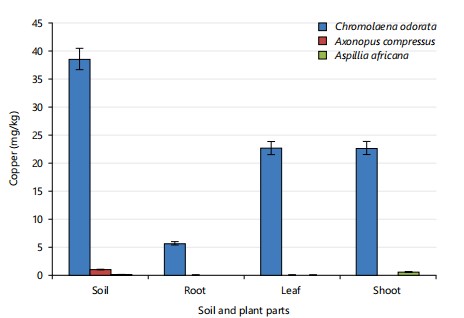
|
TPH accumulation in test plant tissues: The TPH concentration in the shoot revealed that the mean accumulation in C. odorata, A. compressus and A. africana was 13.77, 10.34 and 0.068 mg/kg. The result further showed that TPH content in the leaf of C. odorata accumulated the highest level of TPH (178.43 mg/kg) in the leaf followed by A. compressus (46.58 mg/kg) and A. africana (26.26 mg/kg). The presence of high levels of TPH in plant tissues indicates that the active uptake of hydrocarbons from the soil was taking place (Fig. 11).
Correlation between TPH concentration in soil and plant tissues: In order to understand the relationship between the concentration of TPH in soil and plant tissues, correlation analysis was performed as shown in Fig. 12. Results obtained revealed that there was a significant and positive relationship (r = 0.74, p = 0.004) at 0.05 probability level between spent TPH content in the soil and root. This might be a result of an increase in concentration of TPH in the soil, which also increases the accumulation of TPH by the plant species thus:
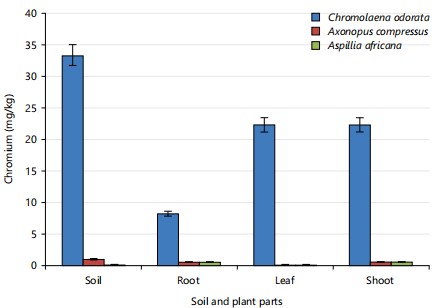
|
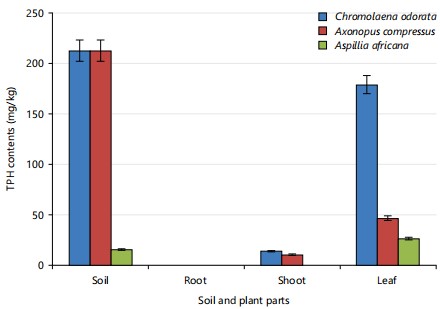
|
where, Y is the concentration of TPH in plant roots and X is the concentration of TPH in soil. This means that TPH level in soil positively correlates with TPH in plant roots. In other words, an increase in TPH level in soil increases TPH content in roots and vice versa.
DISCUSSION
The study has established the accumulation of heavy metals in the roots, shoots and leaves of indigenous plants. As shown in the figures, there was a marked variation in heavy metal accumulation patterns in the different plant tissues (root, leaf and shoot). An increase in TPH level in soil increases TPH content in roots and vice versa.
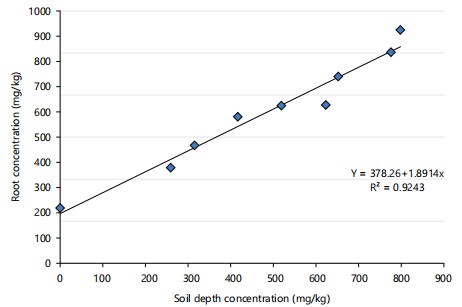
|
This may be an indication that the test plants (C. odorata, A. africana and A. compressus) possess the potential to remediate sites with low to medium contamination19. This was evidenced by the survival and continued, though concentration-dependent reduction in the growth of the test plants, in spent engine oil contaminated soils20,21. The ability of C. odorata, A. africana and A. compressus to grow in soils contaminated with spent engine oil suggests that the species may have the ability to phytodegrade the toxicants resident in spent engine oil (Fig. 1-11). This result was similar to the findings of Ekanem et al.22.
Similar growth responses have been reported for seedlings of Terminalia ivorensis, Terminalia superba and Khaya senegalensis23. A significant and positive correlation was recorded between TPH concentration in soil and plant tissue. This result was in agreement with the report of Ogeleka et al.12. The reason might be that an increase in TPH content in soil resulted to increased level of TPH in plants18.
CONCLUSION
The ability of O. odorata, A. africana and A. compressus to bioaccumulate and transfer heavy metals in their aboveground tissues (root, shoot and leaf) suggested that these plants could be used to remediate spent engine oil contaminated sites. Thus, the three plant species have demonstrated the ability to tolerate heavy metal stress, grow and accumulate biomass in spent engine oil polluted soil. This underscore the need to further explore the adaptability of these indigenous plant species to heavy metals for their selective exploitation in phytoremediation of spent engine oil polluted sites.
SIGNIFICANCE STATEMENT
The ability of three indigenous plant species to remediate spent engine oil-polluted soil was carried out in this study. This was done to apply eco-friendly and cost-effective methods of remediation of polluted sites. This study will enhance our knowledge of the remedial efficacy of indigenous plant species instead of using chemical methods which are costly and environmentally unsafe in the tropics.
REFERENCES
- Alford, É.R., E.A.H. Pilon-Smits and M.W. Paschke, 2010. Metallophytes-A view from the rhizosphere. Plant Soil, 337: 33-50.
- Ameh, A.O., I.A. Mohammed-Dabo, S. Ibrahim, J.B. Ameh, C.D. Azienge and Y. Tanimu, 2011. Earthworm survival in used engine oil contaminated soil spiked with manure. Int. J. Biol. Chem. Sci., 5: 923-929.
- Anukwa, F.A., E.M. Onuoha, A. Nkang and J. Nkereuwem, 2021. Phytoremediation potential of Zea mays L. and Panicum coloratum L. on hydrocarbon polluted soils. Int. J. Bot., 17: 1-7.
- Jidere, C.M. and F.O.R. Akamigbo, 2009. Hydrocarbon degradation in poultry droppings and cassava peels-amended typic Paleustults in Southeastern Nigeria. Agro-Science, 8: 24-30.
- Ekperusi, O.A. and F.I. Aigbodion, 2015. Bioremediation of petroleum hydrocarbons from crude oil-contaminated soil with the earthworm: Hyperiodrilus africanus. 3 Biotech, 5: 957-965.
- Hussain, S., T. Siddique, M. Arshad and M. Saleem, 2009. Bioremediation and phytoremediation of pesticides: Recent advances. Crit. Rev. Environ. Sci. Technol., 39: 843-907.
- Njoku, K.L., M.O. Akinola and B.O. Oboh, 2009. Phytoremediation of crude oil contaminated soil: The effect of growth of Glycine max on the physico-chemistry and crude oil contents of soil. Nat. Sci., 7: 79-87.
- Nwoko, C.O., P.N. Okeke, O.O. Agwu and I.E. Akpan, 2007. Performance of Phaseolus vulgaris L. in a soil contaminated with spent-engine oil. Afr. J. Biotechnol., 6: 1922-1925.
- Odjegba, V.J. and A.O. Sadiq, 2002. Effects of spent engine oil on the growth parameters, chlorophyll and protein levels of Amaranthus hybridus L. Environmentalist, 22: 23-28.
- Cunningham, D.S. and W.R. Berti, 1993. Remediation of contaminated soils with green plants: An overview. In vitro Cell. Dev. Biol.-Plant, 29: 207-212.
- Chijioke-Osuji, C.C., 2016. Effects of waste engine oil on the microflora and physico-chemical quality of soils from two west African countries. Asian J. Environ. Ecol., 1.
- Ogeleka, D.F., P.C. Bokolo and G.O. Omoregie, 2020. Assessment of the phytotoxic effects and ecological risks to Phaseolus vulgaris planted on crude oil spiked soils. Tanzania J. Sci., 46: 116-128.
- Pilon-Smits, E., 2005. Phytoremediation. Annu. Rev. Plant Biol., 56: 15-39.
- Sabaté, J., M. Viñas and A.M. Solanas, 2006. Bioavailability assessment and environmental fate of polycyclic aromatic hydrocarbons in biostimulated creosote-contaminated soil. Chemosphere, 63: 1648-1659.
- Anyasi, R.O. and H.I. Atagana, 2018. Profiling of plants at petroleum contaminated site for phytoremediation. Int. J. Phytorem., 20: 352-361.
- Sharifi, M., Y. Sadeghi and M. Akbarpour, 2007. Germination and growth of six plant species on contaminated soil with spent oil. Int. J. Environ. Sci. Technol., 4: 463-470.
- Singh, O.V. and R.K. Jain, 2003. Phytoremediation of toxic aromatic pollutants from soil. Appl. Microbiol. Biotechnol., 63: 128-135.
- Tóth, G., T. Hermann, M.R. da Silva and L. Montanarella, 2016. Heavy metals in agricultural soils of the European Union with implications for food safety. Environ. Int., 88: 299-309.
- Youssef, D.H. and F.T. Tayel, 2004. Metal accumulation by three Tilapia spp. from some Egyptian inland waters. Chem. Ecol., 20: 61-71.
- Abdel-Shafy, H.I. and M.S.M. Mansour, 2016. A review on polycyclic aromatic hydrocarbons: Source, environmental impact, effect on human health and remediation. Egypt. J. Pet., 25: 107-123.
- Abechi, E.S., O.J. Okunola, S.M.J. Zubairu, A.A. Usman and E. Apene, 2010. Evaluation of heavy metals in roadside soils of major streets in Jos metropolis, Nigeria. J. Environ. Chem. Ecotoxicol., 2: 98-102.
- Ekanem, A.N., V.N. Osabor and B.O. Ekpo, 2019. Polycyclic aromatic hydrocarbons (PAHs) contamination of soils and water around automobile repair workshops in Eket metropolis, Akwa Ibom State, Nigeria. SN Appl. Sci., 1.
- Oketola, A., A. Adebisi and O. Morakinyo, 2013. Distribution and bioavailability of metals in gasoline contaminated sites in Lagos, Nigeria. J. Solid Waste Technol. Manage., 39: 161-172.
How to Cite this paper?
APA-7 Style
Nnawuike,
A.J., Ekene,
I.C., Odinaka,
N.P., Chukwuebuka,
I.M. (2024). Remediation of Spent Engine Oil Polluted Soil Using Indigenous Plant Species. Asian Science Bulletin, 2(4), 435-444. https://doi.org/10.3923/asb.2024.435.444
ACS Style
Nnawuike,
A.J.; Ekene,
I.C.; Odinaka,
N.P.; Chukwuebuka,
I.M. Remediation of Spent Engine Oil Polluted Soil Using Indigenous Plant Species. Asian Sci. Bul 2024, 2, 435-444. https://doi.org/10.3923/asb.2024.435.444
AMA Style
Nnawuike
AJ, Ekene
IC, Odinaka
NP, Chukwuebuka
IM. Remediation of Spent Engine Oil Polluted Soil Using Indigenous Plant Species. Asian Science Bulletin. 2024; 2(4): 435-444. https://doi.org/10.3923/asb.2024.435.444
Chicago/Turabian Style
Nnawuike, Azorji,, JohnPaul, Igwe, Charles Ekene, Nzenwa, Peter Odinaka, and Igbokwe, Moses Chukwuebuka.
2024. "Remediation of Spent Engine Oil Polluted Soil Using Indigenous Plant Species" Asian Science Bulletin 2, no. 4: 435-444. https://doi.org/10.3923/asb.2024.435.444

This work is licensed under a Creative Commons Attribution 4.0 International License.



